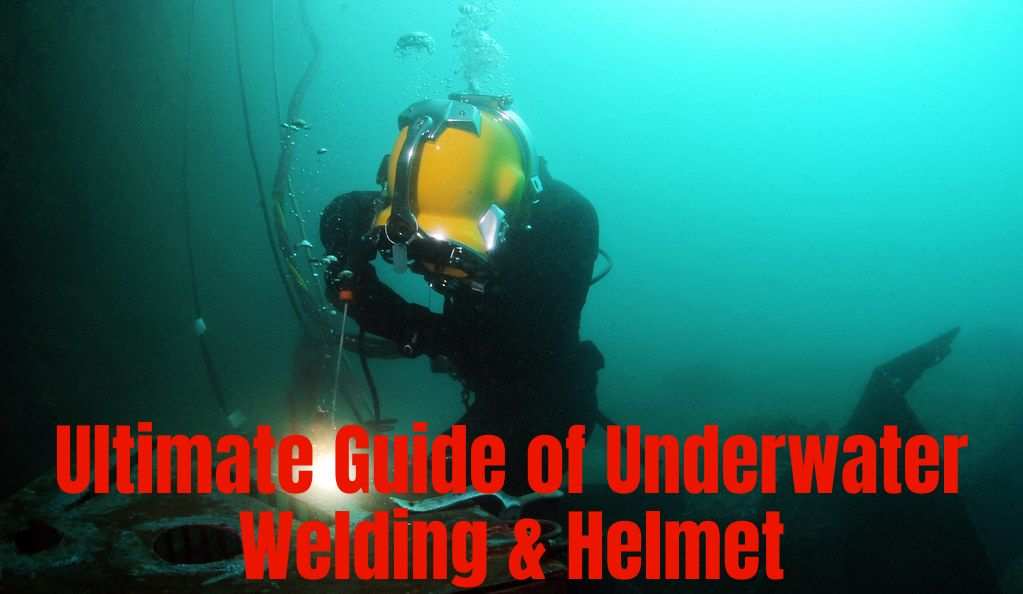A wrong underwater welding helmet is a total tragedy. The helmet for underwater diving is one of those items that is so vital and any mishap with it could seriously affect your performance. If you’re a diver, then you are aware of this already. Let’s begin with the various kinds and then look into the information about the most widely worn caps.
Table of Contents
Underwater Welding Helmet
A diving helmet is not just a device that safeguards the diver from injuries. It also lets the diver breathe air via the umbilical as well as a system of communication that connects the diver with the tenders at the surface.
Divers depend on their team members to “make it hot” when it’s time to switch on the welding equipment’s power or make adjustments when conditions change. Divers usually wear the same helmet as commercial underwater welders but with a welding visor for underwater welding helmet.
The visor is fitted to the helmet of a diving diver to shield divers’ eyes from the arc’s brightness. Projections are available in various colors and styles according to the design and the diver’s preferences.
What Types Of Commercial Diving Welding Helmets Are There?
Welders who work underwater require a sturdy diving helmet to perform their job. On the surface, welding helmets (hoods) shield welders’ eyes and faces when they are working on a welding job. Welding helmets underwater serve this function and allow the welder and diver to breathe.
Most divers use the same diving helmet they wear on a typical commercial dive, but with an additional feature: a welding screen that can be attached to the mask’s front to provide eye protection. The screens can be adjusted up and down, similar to welding hoods, and are available in various shades.
Diving Helmet Types
Underwater welders use different kinds of underwater welding helmets according to the underwater environment and working conditions.
· Open Circuit
The helmet is equipped with gas valves that are non-return and anti-fogging lenses. It also has side weights, an internal cushion, and other contemporary features. It’s the most sought-after safety helmet used by commercial divers. Since it is equipped with an idle valve, the air exhaled is released into the sea.
· Reclaim
The type of helmet is based on the same principle similar to that of the Open Circuit, but it recycles the gas exhaled by the diver and then pumps it back to the system at the same pressure.
· Free-Flow Helmet
The helmet is designed with the most straightforward style. This helmet is highlighted by a more extensive, transparent visor that offers greater visibility. Because of its ease of use, divers can pull the helmet apart and put it back together using a screwdriver and wrench. It’s primarily used in areas with hazardous materials and water that is shallow.
Wet welding uses only an air source supplied by the surface (SSA), and it’s important to note the technology used for SSA is specially designed and only utilized by experts. SSA (as opposed to the more common SCUBA) is vital for underwater welders since it permits communication with the welding machine’s surface crew.
How To Choose A Commercial Underwater Helmet
Once you become aware of different underwater welding helmets models and how their functioning. It’s time to talk about the details of these hoods. However, regardless of the style and model, you select, Here are some tips to remember while making your decision. It is essential to choose a suitable underwater hat for your requirements that doesn’t make your work difficult.
The Return Policy
Check that the store where you purchase your new underwater welding hood comes with at least two weeks of the return policy. It is essential to test the helmet thoroughly. Check everything out and determine if it’s working for you. Commercial divers’ equipment is costly, and the hats are the most expensive part that underwater welding professionals own.
Price
The commercial underwater hats’ prices could range from $6,000 to $10,000 for a brand new one. It could also be feasible to purchase an older helmet because of its long-lasting nature. Underwater welders can make a lot of money so, they must use a good quality underwater welding helmet. Also check the how much underwater welders make in one year.
In this way, you’re in the range of $1,000 to $3000. It may seem more attainable, but it is best only to buy a used helmet if you believe you can be sure that previous owners took good maintenance of the item. Be sure you’re well-prepared for this type of investment. If you’re a beginner diver, consider your experience in the field and potential income. According to our experience in welding industry, we suggest you to always buy a new welding hood.
Are you confident that you’re in the correct position to purchase the equipment you need?
Most of the welding jobs offer welding equipment, same is the case with underwater welding helmet. While on the job, you’ll be held accountable for the hat. It is essential to treat underwater hat with full care. Nearly all jobs will include an ad-hoc policy regarding the care of the cap.
A policy could say that each night after the work is completed, it is your responsibility to clean your hat, examine its condition and feed it. The Company’s hood will save you money, but it also comes with an obligation.
In addition, you need to be sure that the Company is working correctly because you have seen someone else wearing that hat previously and another before them, etc. Therefore, you can avoid purchasing the hat first when you are offered an opportunity that provides the underwater cap, and you are prepared for the responsibilities and the risks that go along with the purchase.
Breathing Function
Let’s start with the technical aspects. One of the most critical aspects is the quality of your breathing in the underwater welding helmet. Test different helmets to find one that gives you to breathe with great effectiveness. Because it can be fatal for your life if it’s not working well. It can be the cause of underwater welder death.
Your breathing should be simple and easy to regulate. We discussed the open circuit or the on-demand airflow helmets earlier and the free flow models. It is common to use air hats on demand often, so make sure that their valves and regulators are of top quality and allow adjustments. Nothing can make your job more difficult than having difficulties breathing under the car’s hood.
Regulators and Valves
The helmet’s regulators should be made from anti-corrosion material. This is a standard feature for modern helmets. It is possible to choose between stainless steel and hard plastics; however, many different materials can be utilized.
Your regulator must be able to make a wide variety of adjustments. This will allow you to modify the breathing setting to meet your specific needs. Valves should be located in an easy-to-access area. However, most models have considered this already. In particular, an emergency air valve.
If you are a diver who welds is a must to have an extra tank in your bag. The tank is connected to the emergency valve that is in your helmet. If the umbilical cord were to cut off or something else occurred, leaving the person without air, they can switch off the emergency valve and then breathe out of the tank.
This tank is usually equipped with a small quantity of oxygen. Only enough to bring you up to the surface. Other valves that your helmet requires are the gas supply return valve and a ventilation valve. The ventilation valve is utilized to clear the view and let the face breathe. The valve for the supply that does not return allows breathing gas to enter through the umbilical cord.
Communication Skills
Commercial diving requires a lot of communication. It is constant direct contact with your topside team. The tender will always communicate with you, direct your workflow while paying attention to your breathing, and remain in readiness if you need to contact assistance.
Underwater Welding Helmet Size
The diving helmet should be comfortable and snug to your head. It shouldn’t be too tight, but it should feel right. It’s something only you will feel and determine that everything is fine. The hat shouldn’t be any bigger than you require.
You can work for months or even minutes on a structure, but regardless, to be effective, your helmet has to be shaped to fit your head.
Everyone who is an expert in sizing takes it seriously, and that’s why you should too. Nearly every commercial diving helmet can allow you to replace one foam padding for another to attain the right fit. So even if you’re not happy with the design, it is still possible to alter it.
The Mobility You Display
Imagine that welder divers aren’t capable of achieving the entire movement. However, many don’t think that an incorrect configuration or the choice of the wrong type of underwater welding helmet can be the reason for this. This can result in a lower level of performance and could hinder your professional career.
Your performance will be better when your mobility is comparable to the one you have in the absence of commercial diving gear. Your neck dam needs to fit your neck nicely to enable this to happen. This might mean trying various models before settling on the right one for you.
The situation could become more complicated with the diving suit you’re using. For instance, if your work requirements necessitate you wearing a dry suit, you will be protected by protection from hazmat particles. However, your mobility is affected unless the suit’s material is suitable for your body and an appropriately sized case.
Conclusion
Every underwater welding job given to a commercial dive team will have distinct specifications and conditions that determine what equipment and tools are required. It also depends on whether the project needs a hyperbaric welding method or a wet weld process. The underwater welding helmet is among the essential equipment required to accomplish this task.

James is a welding expert, accomplished author, and trusted guide with over 8 years of experience in the industry. With his in-depth knowledge and engaging writing style, James has become a true authority in the field, offering readers and clients invaluable expertise and insights to take their welding skills to new heights.

